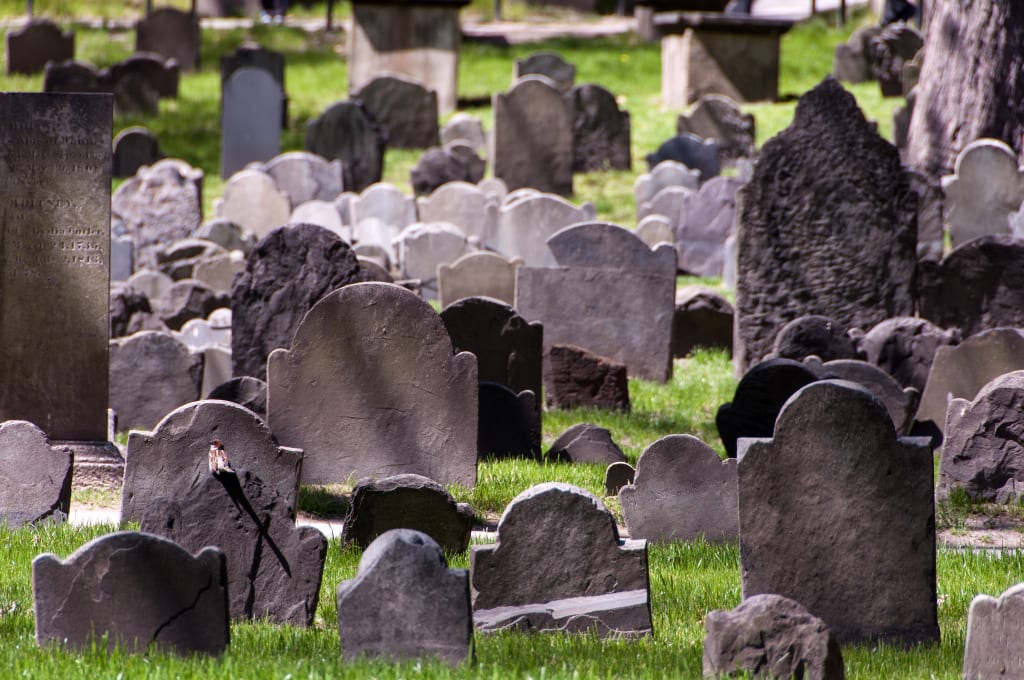Why Do We Bury People 6 Feet Under?
Considering that we're all a little afraid of being buried alive, it seems a bit counter-intuitive.

We've all been to a cemetery at least once in our lives. We all know the feeling of walking between the graves, being careful not to step on the earth over a casket. And we all are well aware that every corpse interred in these macabre city parks is buried 6 feet under. Aren't they?
I have discovered that this assumption is wrong. I will now pause while you reconsider everything you know or think you know.
Everyone good? Awesome. So the question is, how deep do we bury people then? Technically, there is no universal standard - the depth of an individual burial can vary anywhere from 1.5 to 12 feet, and some can be even deeper if you're particularly worried about Grandma rising from the dead. Individual jurisdictions are responsible for setting their own minimum depths, and most are nowhere near 6 feet.
So why do we say that people are 'six feet under?'
Plagues Are the Reason For Everything
Unsurprisingly, this dark idiom originated during the Great Plague of London that occurred in 1665. At this point, the dreaded Black Plague had rocked the international supercenter - 20% of the population died, and the death rate peaked at over 8000 people per week. That's WAY more bodies than any civic municipality should have to deal with.
With the way that the plague was understood at the time, people assumed that the disease continued to spread because the dead were being interred in incredibly shallow graves - after all, it was assumed that disease spread through foul smells in the air, and there's nothing more disgusting than the scent of a rotting corpse. Enter Thomas Bloodworth, the Lord Mayor of London at the time the plague was going on. He enacted a series of rules meant to control the plague, including a mandate that stated that all graves must be a minimum six feet deep. Unfortunately, this particular rule had no bearing on how many people caught the plague.
When the plague eventually stopped, the law would be overturned in England and its affiliated colonies for practical reasons. But this didn't last long; there were other problems concerning cadavers to come.
Body Snatchers Take the Stage
Though the public health reasons for six foot deep graves faded with the Black Plague, there was another scourge creeping across Europe. By the 19th century, advances in medical science had caused a huge increase in the use of human cadavers for teaching and experimental purposes - though most of these bodies were of executed criminals, the indigent, or those who had chosen to donate them, the increasing demand led to a phenomenon that had never been seen before: a shortage of corpses. And, as we all know, any illicit demand will create criminals to supply it.
These particular criminals were known by the grandiose name of Resurrectionists, or by the more common name of body snatchers. They would rob newly dug graves of their occupants and sell them to doctors and medical schools. This became a very profitable practice, with some grave robbers becoming able to dig up four corpses in less than 2 hours each night.
Before you give these guys credit for superhuman powers, however, you have to remember that most bodies were interred about 6 inches beneath the surface. Between that and yanking off the coffin lid, it's totally plausible for an enterprising goon to make off with poor John Doe in about 20 minutes.
Now, this wasn't too much of a problem until the aristocracy began to fear being exhumed, displayed, and dissected along with the criminals and peasants that usually ended up on the table. The law would revert to requiring graves to be 6 feet deep to ease these fears.
What Now?
At the moment, there is no law that exists requiring corpses to interred 6 feet deep - in fact, many states in the US only require 18 inches of soil to be placed on top of a casket or burial vault. Given the height of the average casket, graves that are four feet deep are generally sufficient. Old habits do die hard, so many undertakers still dig six-foot graves as a standard, despite this being somewhat overkill.
There are exceptions to these rules of thumb, particularly in areas with low-lying wetlands like New Orleans and the Caribbean. In these areas, graves that are six feet deep would simply fill with water. Horrifyingly, caskets in this situation are liable to explode from the soil - in fact, early settlers in the area resorted to interring their dead above ground because of this issue. Later on, undertakers in New Orleans would weigh caskets down with rocks to attempt to keep this from happening, but this proved ineffective. Now, above-ground interment in vaults and mausoleums is again becoming popular in these areas.
Exceptions also exist in the case of unusual burials - typical burials involve embalming the body before sealing it inside a sturdy metal casket, which is then placed inside a steel or concrete burial vault before being covered. However, burials do exist where the body is not embalmed, or the casket is made of wood, another natural material, or forgone entirely, or a vault is not used. In these cases, the minimum coverage is two feet of soil; if a casket is included, this would probably result in a grave that is more or less six feet deep.
These standards may seem strange, but there are good reasons for them. Without these protections, soil erosion could result in the bones shifting and surfacing unexpectedly, which is both absolutely terrifying and a possible vector for disease. These minimum depths and somewhat elaborate burial practices make sure the dead stay put - those who are prepping for a zombie apocalypse will appreciate how difficult we're making it for those undead creeps to get to us.
And Now, Some Trivia
Some communities encourage graves that are 12 or more feet deep to allow for relatives to be placed in the same grave later. (A note to my loved ones - I am not sharing.)
In the UK, the decision concerning burial depth is entirely up to the owner of the cemetery plot, provided that the grave is sufficiently deep enough to deter animals from digging it up.
The graves of children and babies are often much shallower than those of adults for obvious reasons - in some regions, the depth is so minimal that the fee for burial can be waived.
The laws for burials on private property are so lax in the UK that it's actually easier to bury a body on your land than it is to build a garage.
About the Creator
Skylar Banach
I'm a freelance writer with an interest in true crime, entertainment, and a wide range of other things.
My avatar was created on Picrew with a generator created by the very talented Hunbloom!






Comments (1)
I Think It's A Good Idea